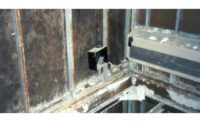The Reasons for Using Rainscreens in Dry Climates

StoVentec® Render is ideal for the Southwest region as it can be specified to achieve a plaster or stucco facade. To learn more, visit https://www.stocorp.com/sto_systems/stoventec-render/
Built environments are essential for human health, safety, and comfort. Properly constructed homes and buildings enable us to live and thrive in any natural environment, many of which would be otherwise virtually unlivable. This is particularly the case in frigid winter conditions or during hot, dry spells out West.
Comprehensive building science principles and solutions such as rainscreens make sense even in places that are typically dry. As of late, these areas are increasingly receiving an abundance of rain during short periods of time. Therefore, rainscreen requirements are making their way into building codes—the laws of the built environment—even for buildings in desert-like climates.
Rainscreens in the Desert
Even in normal weather conditions out West—let alone more extreme, rare, or atmospheric river events—the applicability of rainscreens is being increasingly accepted as a viable option.
This means that traditionally dry climates that naturally experience seasonal rain or snowfall must consider building performance for inevitable bouts of rainfall and flooding.
How is this driving change in the construction industry?
It has driven decision makers in these jurisdictions to reconsider building code recommendations and best practices to create structures that can handle both dry and wet weather. Rainscreens have proven to be a flexible, high-performance exterior cladding choice for both climate types, so they are increasingly making their way onto specification lists.
In a rainy climate, a rainscreen provides a means of ventilation and drainage in the wall cavity, which lends long-term durability to the wall. A proper rainscreen provides resistance to damage from persistent wetness and decay of materials behind the cladding such as sheathing, framing, and drywall. A rainscreen also breaks the force of sideways, wind-driven water movement. Therefore, if any water does get through the small gaps in the rainscreen, it loses quite a bit of momentum before landing there. Water that does sneak past the rainscreen cladding and into the cavity behind simply drains and dries.
Rainscreens have always been critical for marine climates, states on the coast, or regions that consistently experience steady precipitation.
Alternatively, for warmer, drier climates, purposeful use of bi-functional cavities between exterior wall sheathing and cladding is equally as important for moisture and thermal management during times of common extreme weather. This makes for more energy-efficient buildings while simultaneously guarding against bulk moisture intrusion when heavy rains do occur. Take an area such as the Sonoran Desert that typically faces a “feast or famine” monsoon season each summer when the majority of annual rainfall occurs in concentrated deluges. According to the U.S. National Park Service, “Annual precipitation in the Sonoran Desert averages from 76 to 500 mm (3 to 20 inches) depending on location. Whether extreme wet weather event or dry spell, it is critical to take a second look at what materials and systems are being selected for building exteriors in these regions while keeping the exterior wall cavity in mind.
Making the Switch in the West
In the Southwest, adobe-style homes and buildings made from stucco are not hard to find. Stucco is popular in desert-like climates because it is affordable and readily available, but it does not do well in areas with heavy precipitation. This was traditionally not a consideration for regions in the western and southwestern United States.
Seeing as these regions can also be prone to moisture, construction stakeholders are re-evaluating the materials used to clad structures here.
Not only are building codes recommending rainscreen cladding usage in dry climates, but for the first time, the new 2021 International Building Code (IBC) and International Residential Code (IRC) have prescribed a minimum cavity depth for rainscreen applications. This is the first time a minimum depth has been prescribed in the U.S. model building codes, and it presents a strong opportunity for rainscreen specification.
The cavity to which the code refers occurs between the rainscreen cladding/finish and the weather-resistive barrier materials behind it, and it is now recommended to be at a minimum range of 3/16 inches (4.8 mm) deep for stucco cladding in moist or marine climates specifically. This gap provides the building with the adequate amount of space for drainage and ventilation. For dry climates, particularly regarding the use of stucco, the building code has enhanced the weather barrier minimums and recommends a drainage space behind the stucco to meet demands for water resistance. However, the code does not yet specify a minimum cavity depth. In fact, the Rainscreen Association in North America (RAiNA) illustrates various rainscreen cavity depths based on building requirements or design intent.
Cavity depth is a critical change to the building code, and it is no longer imperative for northern or marine climates only. If snow, water, or moisture gets behind rainscreen cladding in any environment without the proper ventilation and drainage plane, it can lead to an exterior wall that can only be described as problematic for owners and occupants. If moisture soaks into the materials behind the cladding, it is going to stay wet. Repeated over time, this can lead to a weakened structural system or sick building syndrome, which has adverse effects on the structure and the health of those inside.
The Future of Façades
Moving forward, construction professionals should take the new standards regarding cavity depth into consideration when designing structures. Creating more resilient buildings is a critical mechanism for good environmental stewardship and for countering the effects of weather extremes and a changing climate. The fact that cavity depth has been built into the code provides an excellent opportunity for the specification of rainscreen systems.
Today’s leading rainscreen manufacturers are offering systems that can be specified to look like plaster or stucco, ideal for the Southwest. However, because it is part of a rainscreen system, it is built off the substrate to meet the suggested cavity depth. This permits builders, developers, and owners in the Southwest who still prefer a stucco look to achieve their desired aesthetic in a much higher-performing, code-compliant system. This has traditionally not been an option, but it is one that specifiers nationwide are taking advantage of to deliver virtually any look they desire in an integrated system; one that provides unparalleled longevity, performance, and health for the structure.
In dry climate zones, rainscreen systems present a chance for performance-minded professionals who think long term and seek to upgrade exteriors to exceed the code minimum. Given the recent wet winter weather in the western U.S., rainscreens are now a viable option, rain or shine.
Of course, rainscreen systems are also a good choice when those hot, sunny, and dry regions are experiencing their typical weather conditions. With new product innovations, architects and designers can choose from various high-performance finishes such as masonry veneer and glass as well as finishes that deliver a brick, wood, metallic, marble, stone, or granite aesthetic, all of which will hold up under the hot sun. When installed via an integrated rainscreen system, projects in the West and Southwest can achieve the desired aesthetic but now with the performance that considers both dry and wet weather.
Earth, Wind, and Fire... and Rain
Modern-day rainscreen solutions must contemplate more than just water intrusion. Exterior cladding is the first line of defense against wind and rain. For hot and arid regions, fire-resistant materials are also crucial.
Systems such as StoVentec® are fastened to the wall via a sub-construction called StoVentro™, which is an adjustable, thermally efficient structural system of brackets and rails for attachment. This allows the system to meet the latest IBC and IRC requirements for rainscreen depth, but it also delivers fire performance via its integrated continuous exterior insulation that is non-combustible and tested to rigorous NFPA 285 standards. Therefore, the rainscreen system is firing on all cylinders:
- Proper rainscreen depth
- Fire resistance
- Energy efficiency
- Water resistance
Translation?
One integrated system that checks all the boxes for exterior wall performance.
The industry can be slow to adopt new construction practices. Therefore, full implementation of rainscreens in dry climates won’t happen overnight. However, rainscreen systems provide real and tangible benefits for designers, owners, and occupants in wet or dry climate zones throughout the United States and beyond, and specifiers in the western U.S. are beginning to take note.
Looking for a reprint of this article?
From high-res PDFs to custom plaques, order your copy today!





